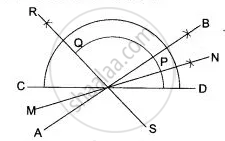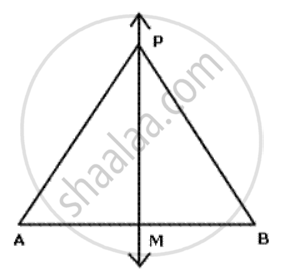Advertisements
Advertisements
प्रश्न
Draw two intersecting lines to include an angle of 30°. Use ruler and compasses to locate points which are equidistant from these Iines and also 2 cm away from their point of intersection. How many such points exist?
उत्तर १

Draw an angle bisectcr PQ and RS of angles formed by the lines m and n. From centre draw a circle with radius 2 cm, whidi intersect the angle bisectors at a, b, c and d respectively.
Hence, a, b, c and d are the required four points.
उत्तर २
AB and CD are two intersecting lines at an angle of 30°. Their point of intersection is O.
Draw MON and ROS, the bisector of angles between AB and CD. On ON, locate a point P such that OP = 2 cm.
On OR locate a point Q such that OQ = 2 cm.
Since, P and Q are on the angle bisectors of angles between AB and CD, hence each of P and Q is equidistant from AB and CD.
Also, OP = 2 cm
Hence, P and Q are the required points.
संबंधित प्रश्न
Describe the locus of vertices of all isosceles triangles having a common base.
O is a fixed point. Point P moves along a fixed line AB. Q is a point on OP produced such that OP = PQ. Prove that the locus of point Q is a line parallel to AB.
Draw an angle ABC = 75°. Find a point P such that P is at a distance of 2 cm from AB and 1.5 cm from BC.
Plot the points A(2, 9), B(–1, 3) and C(6, 3) on graph paper. On the same graph paper draw the locus of point A so that the area of ΔABC remains the same as A moves.
A and B are fixed points while Pis a moving point, moving in a way that it is always equidistant from A and B. What is the locus of the path traced out by the pcint P?

In given figure 1 ABCD is an arrowhead. AB = AD and BC = CD. Prove th at AC produced bisects BD at right angles at the point M

Describe completely the locus of point in the following cases:
Centre of a ball, rolling along a straight line on a level floor.
Using a ruler and compass only:
(i) Construct a triangle ABC with BC = 6 cm, ∠ABC = 120° and AB = 3.5 cm.
(ii) In the above figure, draw a circle with BC as diameter. Find a point 'P' on the circumference of the circle which is equidistant from Ab and BC.
Measure ∠BCP.
Use ruler and compasses only for this question. Draw a circle of radius 4 cm and mark two chords AB and AC of the circle of length f 6 cm and 5 cm respectively.
(i) Construct the locus of points, inside the circle, that are equidistant from A and C. Prove your construction.
(ii) Construct the locus of points, inside the circle, that are equidistant from AB and AC.
Ruler and compass only may be used in this question. All construction lines and arcs must be clearly shown, and be of sufficient length and clarity to permit assessment.
(i) Construct Δ ABC, in which BC = 8 cm, AB = 5 cm, ∠ ABC = 60°.
(ii) Construct the locus of point inside the triangle which are equidistant from BA and BC.
(iii) Construct the locus of points inside the triangle which are equidistant from B and C.
(iv) Mark as P, the point which is equidistant from AB, BC and also equidistant from B and C.
(v) Measure and record the length of PB.
